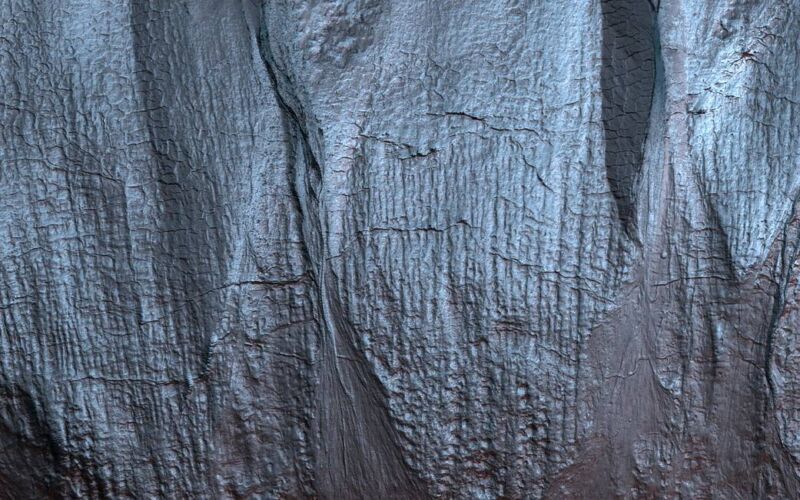Subliminal —
Lab experiments suggest gullies on Mars might form when carbon dioxide heats up.

Mars has a history of liquid water on its surface, including lakes like the one that used to occupy Jezero Crater, which have long since dried up. Ancient water that carried debris—and melted water ice that presently does the same—were also thought to be the only thing driving the formation of gullies spread throughout the Martian landscape. That view may now change thanks to new results that suggest dry ice can also shape the landscape.
It’s sublime
Previously, scientists were convinced that only liquid water shaped gullies on Mars because that’s what happens on Earth. What was not taken into account was sublimation, or the direct transition of a substance from a solid to a gaseous state. Sublimation is how CO2 ice disappears (sometimes water ice experiences this, too).
Frozen carbon dioxide is everywhere on Mars, including in its gullies. When CO2 ice sublimates on one of these gullies, the resulting gas can push debris further down the slope and continue to shape it.
Led by planetary researcher Lonneke Roelofs of Utrecht University in the Netherlands, a team of scientists has found that the sublimation of CO2 ice could have shaped Martian gullies, which might mean the most recent occurrence of liquid water on Mars may have been further back in time than previously thought. That could also mean the window during which life could have emerged and thrived on Mars was possibly smaller.
“Sublimation of CO2 ice, under Martian atmospheric conditions, can fluidize sediment and creates morphologies similar to those observed on Mars,” Roelofs and her colleagues said in a study recently published in Communications Earth & Environment.
Into thin air
Earth and Martian gullies have basically the same morphology. The difference is that we’re certain that liquid water is behind their formation and continuous shaping and re-shaping on Earth. Such activity includes new channels being carved out and more debris being taken to the bottom.
While ancient Mars may have had enough stable liquid water to pull this off, there is not enough on the present surface of Mars to sustain that kind of activity. This is where sublimation comes in. CO2 ice has been observed on the surface of Mars at the same time that material starts flowing.
After examining observations like these, the researchers hypothesized these flows are pushed downward by gas as the frozen carbon dioxide sublimates. Because of the low pressure on Mars, sublimation creates a relatively greater gas flux than it would on Earth—enough power to make fluid motion of material possible.
There are two ways sublimation can be triggered to get these flows moving. When part of a more exposed area of a gully collapses, especially on a steep slope, sediment and other debris that have been warmed by the Sun can fall on CO2 ice in a shadier and cooler area. Heat from the falling material could supply enough energy for the frost to sublimate. Another possibility is that CO2 ice and sediment can break from the gully and fall onto warmer material, which will also trigger sublimation.
Mars in a lab
There is just one problem with these ideas: since humans have not landed on Mars (yet), there are no in situ observations of these phenomena, only images and data beamed back from spacecraft. So, everything is hypothetical. The research team would have to model Martian gullies to watch the action in real time.
To re-create a part of the red planet’s landscape in a lab, Roelofs built a flume in a special environmental chamber that simulated the atmospheric pressure of Mars. It was steep enough for material to move downward and cold enough for CO2 ice to remain stable. But the team also added warmer adjacent slopes to provide heat for sublimation, which would drive movement of debris. They experimented with both scenarios that might happen on Mars: heat coming from beneath the CO2 ice and warm material being poured on top of it. Both produced the kinds of flows that had been hypothesized.
For further evidence that flows driven by sublimation would happen under certain conditions, two further experiments were conducted, one under Earth-like pressures and one without CO2 ice. No flows were produced by either.
“For the first time, these experiments provide direct evidence that CO2 sublimation can fluidize, and sustain, granular flows under Martian atmospheric conditions,” the researchers said in the study.
Because this experiment showed that gullies and systems like them can be shaped by sublimation and not just liquid water, it raises questions about how long Mars had a sufficient supply of liquid water on the surface for any organisms (if they existed at all) to survive. Its period of habitability might have been shorter than it was once thought to be. Does this mean nothing ever lived on Mars? Not necessarily, but Roelofs’ findings could influence how we see planetary habitability in the future.
Communications Earth & Environment, 2024. DOI: 10.1038/s43247-024-01298-7